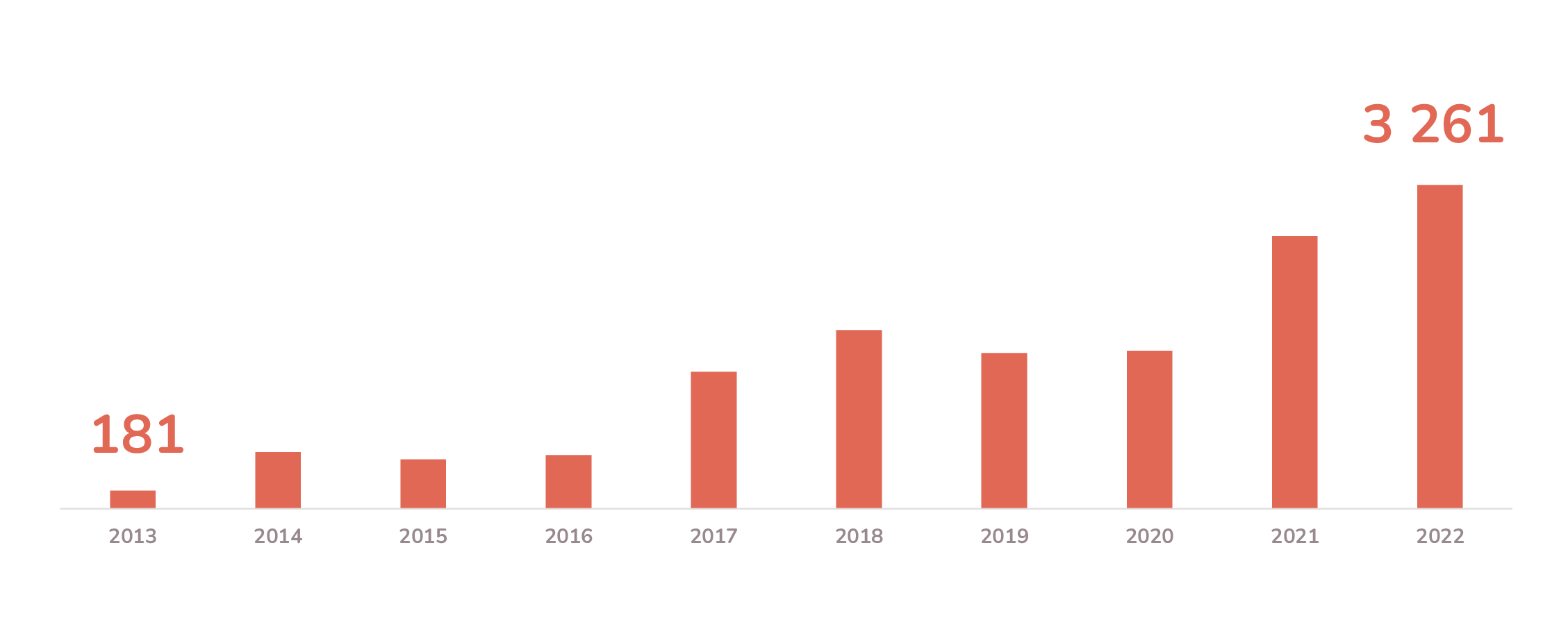Pavla Kaňková
+420 771 297 711
18. 12. 2023
Feedback is a challenging discipline, especially when it comes to the radical openness approach. Radical openness seeks to strike a balance between directness and authentic interest in the person. This approach has begun to resonate with many people recently.
Guidance on how to deal successfully with feedback, whether from the position of the giver or the receiver, is widely available and well known. But let’s look at feedback from a different perspective. In what ways can it be obtained? How can you organize it if you are in an HR or managerial role? And what to look out for when doing so? Read on for tips based on real-life experience.

It’s no secret that face-to-face feedback is often very hard to give. You can read motivational books, go through the best training sessions, but in practice, very few people want to give feedback. Even praise is sometimes hard to give and often makes the recipient uncomfortable. And what about when the feedback is negative and unsolicited? It can make a person feel uncomfortable, awkward and embarrassed. In fact, there is much to lose in a personal confrontation and gains are not guaranteed.
Greater security and comfort for both the “giver” and “receiver” of feedback can be ensured by making feedback anonymous, online, from multiple people, in a certain logical structure, and by making it asynchronous. Those who give feedback have time and peace of mind to reflect on it. And those who receive it have time and space to absorb it.
With structured feedback from multiple people who actually know you, you are more likely to get realistic feedback. And there might even be an “aha moment” and a realization of something useful that you weren’t aware of before. If 6 out of 8 comments say that a person slips into arrogance at times and colleagues don’t argue with them just because they are afraid of them, there is probably something to it.
But it’s not just about criticism. Feedback can be good “medicine” when a person underestimates themselves, overlooking their qualities as normal. It can also help in the case of full-blown imposter syndrome. When several colleagues independently mention in feedback that the recipient is the one who keeps the atmosphere in the team and that they appreciate how they are always readily available to newcomers or how great they are at dealing with clients, they don’t automatically appear in the output.
A typical tool for structured feedback from different groups of co-workers is the 360° Feedback. The fact that the popularity of the 360° feedback is not declining but increasing is evidenced by the data we have from the implementations. The number of participants is constantly growing. For example, the data show that from the beginning of the year to the end of September 2023, over 3,500 participants have carried out an online 360° feedback with the help of our tool. And we still have a strong end of the year ahead of us. So we are already seeing a significant increase compared to previous years.

Sometimes, we need to have feedback right away and can’t wait for an organized activity for the whole management or an annual review. With instant feedback tools such as Perfeed, feedback can be collected immediately after a meeting, presentation, or after a project is completed. At the same time, we can collect this feedback repeatedly and continuously see on the data how we are improving or vice versa. It’s no longer just about “feelings” but about shifts that are actually supported by data.
It is also human nature to have “biases”, i.e. conscious or unconscious errors in judgment caused by likes or dislikes or various prejudices. Feedback from co-workers can sometimes be positively biased because we (mostly) like our colleagues or bosses. Conversely, everyone has probably had a “dig” at someone at some point. That’s why a useful format for feedback tends to be the multiple variants of Development Centers, in which the participant receives feedback from independent observers who have to agree on the evaluation to eliminate individual “bias”.
It is constantly confirmed in practice that the chances of real change, shift, or development are fundamentally increased by the presence of someone who helps us to make the issues present, to name them, and – above all – to define the next steps. It is also important to follow these next steps together with us, because, when pressed for time, development is often the first thing to be sacrificed. And that is what usually happens. Whether the role of “guide” is played by a manager, someone from HR, an internal or external mentor, a coach, or a trainer, it is an extremely important role.
Surveys can be done in a variety of ways, from quick polls on an infinite number of topics and repeated pulse surveys (often mapping just a few points) to traditional annual or biennial surveys that cover a range of areas and allow for continuity over time and comparison with other companies through benchmarking.
In practice, we have found that the idea of a constant, perhaps weekly, supply of “fresh” data is very appealing in theory, but in reality, enthusiasm can quickly fade as there is simply no time to continuously evaluate data and implement action plans when running a regular agenda. It is therefore necessary to consider the reality of a particular company – its culture, size, complexity of processes, and management of expectations – and choose the best approach to surveys and feedback in general accordingly.
Sometimes feedback just doesn’t get done. Perhaps because the parties involved don’t know the basic principles of how to give or receive feedback, and the feedback turns into an emotionally charged confrontation or a settling of accounts.
The cause may be a lack of knowledge of “how to do it”. The solution is to explain the principles, and train in effective feedback, or just practice the skills to give and receive feedback. If you don’t have time for training or aren’t a fan of reading all the trendy books, Blinkist will help you catch all the essentials in a few minutes. In practice, the “quick jam” works great too.
Unfortunately, some people have had a negative experience of feedback from the past. For example, when challenged, they honestly tell their supervisor their grievances and then the honesty backfires because they fall out of favor. We have also encountered a 360° feedback project that was presented as a development project, but was, in fact, a hidden audit. The results then had much wider implications. Unfortunately, such breaches of trust usually make any well-intentioned development activity difficult for a long time to come.
Transparency about the meaning and purpose of feedback and strict compliance with agreements is essential. Clear communication is absolutely crucial. If you plan to implement any feedback tools, it pays to have face-to-face or online meetings, kick-off meetings, and allow for discussion and provide space for questions and objections. Listening to criticism, concerns, patiently explaining and consistently following through on all agreements just works. Although it takes time, it pays off.
As we mentioned earlier, people want feedback. But not all of them and not always. What about those who fundamentally resist it?
It can be carried out on a voluntary basis. But this is hardly possible, for example in the case of regular evaluation or where feedback is an integral part of development programs. Again, patient communication may be the solution. If someone resists feedback, there is probably a reason. By drawing the participants into the discussion (or even into the project design and feedback process), we give them space to air their concerns, let them know in detail what is going to happen and why, what it will look like, or work together to come up with an alternative approach.
A dismissive attitude is generally difficult to work with. It cannot be trained or provided by directives. But what we do know is that examples do attract. In practice, ‘pilot squadrons’ – groups of volunteers who lead by example (often from the highest levels of management) – often help. They tend to be ambassadors of feedback and living proof that it is possible to survive and nothing negative happens; rather the feedback helps to improve the atmosphere, relationships and communication.
When feedback is recorded in any written form, it is important to be clear about who receives it and why. And here again the need for clear and transparent communication and consequent compliance with agreements is reaffirmed. Typically, feedback is handled not only by the recipient, but also by the aforementioned guides – managers, HR representatives or external coaches, for example. And everyone involved should know about it.
Feedback is incredibly important and useful, and what’s more – it has to be learned. So “guides” – be they mentors, trainers or coaches – and online tools that clearly measure our progress are useful aids to continuous development. As the saying goes, “What gets measured gets improved.” However, even the best tools can sometimes cause damage through clumsy or improper handling, which is why the role of managers and “HR people” is still absolutely crucial, and no AI will replace it, at least not in the foreseeable future.
Author: Marta Fabiánová, Managing Director TCC online, HR news

29. 04. 2025
A great expert doesn’t automatically make a great leader. So, how can we reduce the risk of ruining a talented individual or a...
27. 03. 2025
Can you reliably identify great salespeople during the hiring process? What are the key traits and competencies that make a successful...